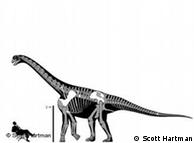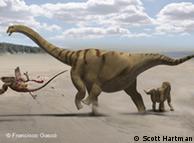Science | 23.02.2011
Paleontologists discover 'thunder-thighs' dinosaur
A new dinosaur nicknamed "Thunder Thighs" after its powerful legs has been discovered in the United States. The new species, officially named Brontomerus mcintoshi, was announced in the journal Acta Palaeontologica Polonica by a team of US and UK scientists on Wednesday.
The name Brontomerus, which is Latin for thunder thighs, is derived from the size and shape of the hip bone. The bones suggest the reptile had the largest leg muscles of any dinosaurs in the long-necked sauropod family.
The fossilized remains of an adult and a juvenile Brontomerus were discovered in a quarry in the US state of Utah. Scientists speculated that the larger was the mother and would have been about the size of a large elephant, weighed about six tons and been some 14 meters (46 feet) long, while the juvenile would have been the size of a pony.
Legs made for kicking
Unsurprisingly, it's the massive hips of this dinosaur that are behind most of the attention it's currently receiving.
 Bildunterschrift: Großansicht des Bildes mit der Bildunterschrift: The adult found would have been the size of a large elephant
Bildunterschrift: Großansicht des Bildes mit der Bildunterschrift: The adult found would have been the size of a large elephant"When we recognized the weird shape of the hip, we wondered what its significance might be, but we concluded that kicking was the most likely," Mike Taylor, a researcher at University College London and an author of the journal article, said in a press release.
"The kick would probably have been used when two males fought over a female, but, given that the mechanics were all in place, it would be bizarre if it wasn't also used in predator defense," he added.
Not just Jurassic
In addition to its powerful thighs, the discovery has also added weight to the view that sauropods were not extinct by the Early Cretaceous period as paleontologists have thought, according to the study's co-author Matt Wedel from the Western University of Health Sciences, in Pomona, California.
Sauropods were abundant in the Jurassic period, which lasted from roughly 200 million years ago to 145 million years ago, and very rare by the Early Cretaceous period, which was about 145 million years ago to 65 million years ago. But the Brontomerus, estimated to have lived approximately 110 million years ago, shows the sauropods' time roaming the Earth didn't end with the Jurassic period, Wedel explained.
"We are finding more sauropods from the Early Cretaceous period, and the picture is changing," Wedel said. "It now seems that sauropods may have been every bit as diverse as they were during the Jurassic, but much less abundant and so much less likely to be found."
Author: Stuart Tiffen
Editor: Sean Sinico
dw


No comments:
Post a Comment